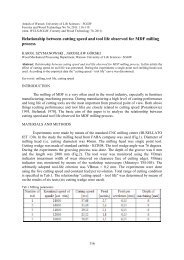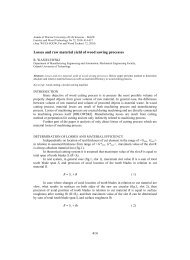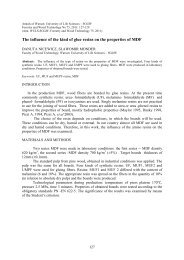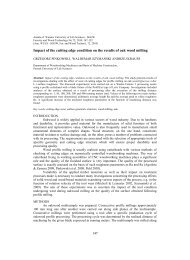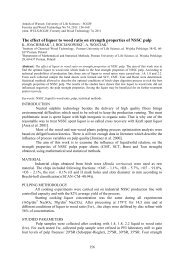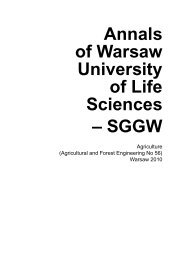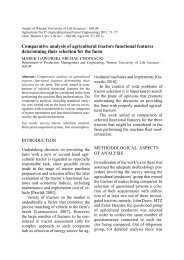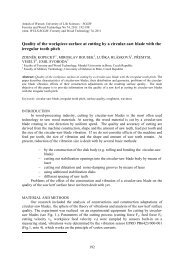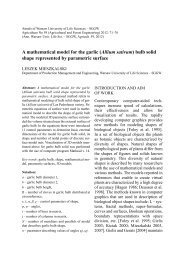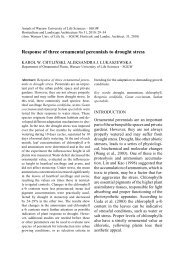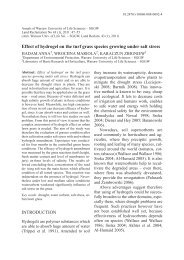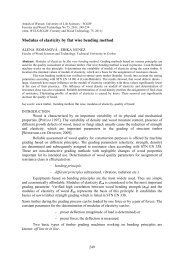Annals of Warsaw University of Life Sciences – SGGW. Animal ...
Annals of Warsaw University of Life Sciences – SGGW. Animal ...
Annals of Warsaw University of Life Sciences – SGGW. Animal ...
Create successful ePaper yourself
Turn your PDF publications into a flip-book with our unique Google optimized e-Paper software.
28 J. Gajewska et al.<br />
parison to the controlled group. The<br />
number <strong>of</strong> beneficial microorganisms<br />
which protect against pathogens has<br />
increased. The effect <strong>of</strong> this probiotic<br />
bacteria in lactic fermentation can lead<br />
to the improvement <strong>of</strong> general condition<br />
and health <strong>of</strong> broiler chickens.<br />
There were no significant differences<br />
in the number <strong>of</strong> heterotrophic intestine<br />
bacteria between the experimental and<br />
controlled group. This can be caused by<br />
the higher number <strong>of</strong> lactic acid bacteria,<br />
not the pathogens. No pathogenic<br />
bacteria such as: Samonella sp., Shigella<br />
sp., E. coli beta haemolytic and Clostridium<br />
perfringens reducing sulphate were<br />
observed (in both examined cut <strong>of</strong> the<br />
digestive contents <strong>of</strong> the small intestine).<br />
There was an insignificant number<br />
<strong>of</strong> microscopic fungi (yeast and hyphal<br />
fungi) at the low level (below10 2 ⋅jtk⋅g <strong>–</strong>1 )<br />
(in the digestive contents <strong>of</strong> the small<br />
intestine from the experimental group).<br />
This can be a result <strong>of</strong> high number <strong>of</strong><br />
such bacteria as Lactobacillus sp. in this<br />
group. This bacteria acidifies its environment<br />
by producing lactic acid, and<br />
the low reaction (pH) is responsible for<br />
the fungi increase. Furthermore, that<br />
the antagonistic lactic bacterial strain in<br />
comparison to fungi seemed to be inefficient<br />
for lactic bacteria fermentation<br />
and (LAB) the general condition and<br />
health condition <strong>of</strong> broiler chicken can<br />
be improved. L-carnitine has detoxifying<br />
features due to the chelates ability. However,<br />
the chelations ability is common<br />
almost in every organic acid, nevertheless<br />
only few kinds <strong>of</strong> such substances<br />
can be considered as an exemplary. The<br />
exemplary chelates substances with the<br />
optimum biding ability are as follows:<br />
ascorbic acid and L-carnitine. L-carnitine<br />
facilitates the absorption and transport<br />
<strong>of</strong> bioelements and keep them in the<br />
body store, returning them to metabolism<br />
when needed, removes potentially<br />
destructive surplus <strong>of</strong> bioelements and<br />
eliminate toxic elements (Ambroziak,<br />
2000).<br />
The Figure 2 shows the results <strong>of</strong><br />
coli/lacto calculated on the basis <strong>of</strong> the<br />
proportion <strong>of</strong> the Enterobacteriaceace to<br />
Lactobacillaceae number. Aminikarnifarm<br />
did not have a significant effect<br />
on lowing coli/lacto coefficient in the<br />
small intestine. However, above mentioned,<br />
coli/lacto was low (below 1) in<br />
the experimental and controlled group,<br />
which shows proper and positive composition<br />
<strong>of</strong> intestine micro flora. In the<br />
Gajewska’s research (2009) a positive<br />
effect <strong>of</strong> plant preparations on the intestine<br />
micro flora <strong>of</strong> broiler chicken can be<br />
seen. When used with the Digestarom<br />
preparation coli/lacto was 0.14. Some<br />
authors claimed that the results where<br />
poultry farmers use herb preparations,<br />
are comparable to antibiotic growth<br />
stimulators used in the past such as: avilamycine<br />
(Jamroz, Kamel, 2004; Lee at<br />
al., 2004).<br />
log jtk g <strong>–</strong>1 bw<br />
0,9<br />
0,7<br />
0,5<br />
0,3<br />
0,1<br />
Control<br />
Aminokarnifarm<br />
FIGURE 2. Coefficient coli/lacto in the small intestine<br />
micr<strong>of</strong>lora basing on the Aminokarnifarm<br />
experiment



